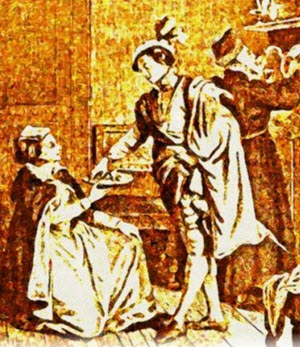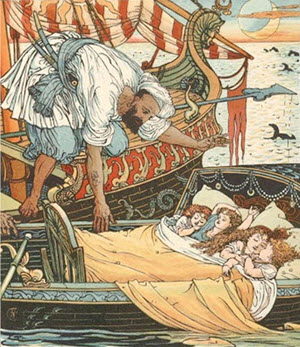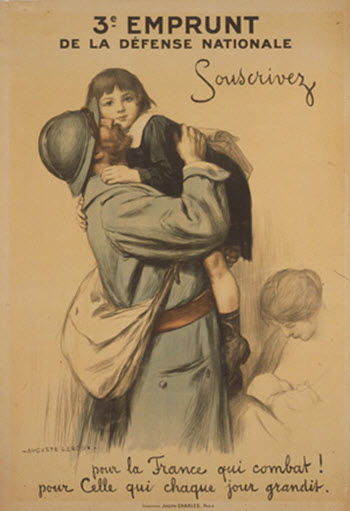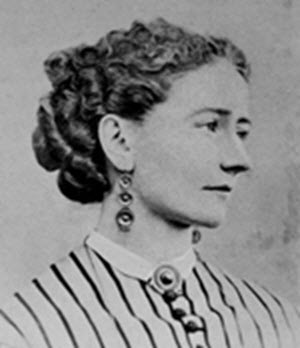Home > Secret Rooms and Hiding Places > >
Chapter: [1] [2] [3] [4] [5] [6] [7] [8] [9] [10] [11] [12] [13] [14] [15] [16] [17]
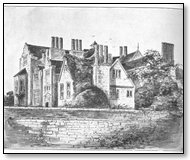
SHOWING ENTRANCE TO HIDING PLACE, SALFORD PRIOR
SCOTTISH CASTLES
During the Jacobite risings of 1715 and 1745 some of the "priest's holes" in the old Roman Catholic houses, especially in the north of England and in Scotland, came into requisition not only for storing arms and ammunition, but, after the failure of each enterprise, for concealing adherents of the luckless House of Stuart.
In the earlier mansion of Worksop, Nottinghamshire (burnt down in 1761), there was a large concealed chamber provided with a fireplace and a bed, which could only be entered by removing the sheets of lead forming the roofing. Beneath was a trap-door opening to a precipitous flight of narrow steps in the thickness of a wall. This led to a secret chamber, that had an inner hiding-place at the back of a sliding panel. A witness in a trial succeeding "the '45" declared to having seen a large quantity of arms there in readiness for the insurrection.
The last days of the notorious Lord Lovat are associated with some of the old houses in the north. Cawdor Castle, Nairnshire, and Netherwhitton, in Northumberland, claim the honour of hiding this double-faced traitor prior to his arrest. At the former is a small chamber near the roof, and in the latter is a hiding-place measuring eight feet by three and ten feet high. Nor must be forgotten the tradition of Mistress Beatrice Cope, behind the walls of whose bedroom Lovat (so goes the story) was concealed, and the fugitive, being asthmatical, would have revealed his whereabouts to the soldiers in search of him, had not Mistress Cope herself kept up a persistent and violent fit of coughing to drown the noise.
.A secret room in the old Tudor house Ty Mawr, Monmouthshire, is associated with the Jacobite risings. It is at the back of "the parlour" fireplace, and is entered through a square stone slab at the foot of the staircase. The chamber is provided with a small fireplace, the flue of which is connected with the ordinary chimney, so as to conceal the smoke. The same sort of thing may be seen at Bisham Abbey, Berks.
Early in the last century a large hiding-place was found at Danby Hall, Yorkshire. It contained a large quantity of swords and pistols. Upwards of fifty sets of harness of untanned leather of the early part of the eighteenth century were further discovered, all of them in so good a state of preservation that they were afterwards used as cart-horse gear upon the farm.
No less than nine of the followers of "Bonnie Prince Charlie" are said to have been concealed in a secret chamber at Fetternear, Kemnay, Aberdeenshire, an old seat of the Leslys of Balquhane. It was situated in the wall behind a large bookcase with a glazed front, a fixture in the room, the back of which could be made to slide back and give admittance to the recess.
Quite by accident an opening was discovered in a corner cupboard at an old house near Darlington. Certain alterations were in progress which necessitated the removal of the shelves, but upon this being attempted, they descended in some mysterious manner. The back of the cavity could then be pushed aside (that is to say, when the secret of its mechanism was discovered), and a hiding-place opened out to view. It contained some tawdry ornaments of Highland dress, which at one time, it was conjectured, belonged to an adherent of Prince Charlie.
The old mansion of Stonyhurst, Lancashire, contained eight hiding-places. One of them, exactly like that at Fetternear, was at the back of a bookcase. A secret spring was discovered which opened a concealed door in the wall. In the space behind, a quantity of James II. guineas, a bed, a mattress, and a flask of rum were found. A former student of this famous Jesuit college, who was instrumental in the discovery of a "priest's hole," has provided us with the following particulars: "It would be too long to tell you how I first discovered that in the floor of my bedroom, in the recess of the huge Elizabethan bay window, was a trap-door concealed by a thin veneering of oak; suffice it say that with a companion I devoted a delightful half-holiday to stripping off the veneering and breaking the lock of the trap-door. Between my floor and the ceiling of the long gallery below, was contrived a small room about five feet in height and the size and shape of the bay window recess. In one corner of this hiding-hole was what seemed a walled-up doorway, and it occurred to my companion and myself that we had heard some vague old tradition that all this part of the house was riddled with secret passages leading from one concealed chamber to another, but we did not seek to explore any farther." In pulling down a portion of the college, a hollow beam was discovered that opened upon concealed hinges, used formerly for secreting articles of value or sacred books and vessels; and during some alterations to the central tower, over the main entrance to the mansion, a "priest's hole" was found, containing seven horse pistols, ready loaded and some of them richly ornamented with silver. A view could be obtained from the interior of the hiding-place, in the same manner as that which we have described in the old summer-house at Salisbury; a small hole being devised in the design of the Sherburn arms upon the marble shield over the gateway. This was the only provision for air and light.
The quaint discovery of rum at Stonyhurst suggests the story of a hiding-place in an old house at Bishops Middleham, near Durham, mentioned by Southey in his Commonplace Book. The house was occupied for years by a supposed total abstainer; but a "priest's hole" in his bedroom, discovered after his death full of strong liquor, revealed the fact that by utilising the receptacle as a cellar he had been able to imbibe secretly to his heart's content.
A large quantity or Georgian gold coins were found some years ago in a small hiding-place under the oaken sill of a bedroom window at Gawthorp Hall, Lancashire, placed there, it is supposed, for the use of Prince Charles's army in passing through the country in 1745.
The laird of Belucraig (an old mansion in the parish of Aboyne, Aberdeenshire) was concealed after "the '45" in his own house, while his wife, like the hostess of Chastleton, hospitably entertained the soldiers who were in search of him. The secret chamber where he was concealed was found some years ago in making some alterations to the roof. In it were a quantity of Jacobite papers and a curious old arm-chair. The original entry was through a panel at the back of a "box bed" in the wainscot of a small, isolated bedroom at the top of the house. The room itself could only be reached by a secret staircase from a corridor below. The hiding-place was therefore doubly secure, and was a stronghold in case of greatest emergency. The Innes of Drumgersk and Belucraig were always staunch Roman Catholics and Jacobites. Their representatives lived in the old house until 1850.
In another old Aberdeenshire mansion, Dalpersie House, a hiding-hole or recess may be seen in one of the upper chambers, where was arrested a Gordon, one of the last victims executed after "the 45."
.The ancient castles of Fyvie, Elphinstone, and Kemnay House have their secret chambers. The first of these is, with the exception of Glamis, perhaps, the most picturesque example of the tall-roofed and cone-topped turret style of architecture introduced from France in the days of James VI. A small space marked "the armoury" in an old plan of the building could in no way be accounted for, it possessing neither door, window, nor fireplace; a trap-door, however, was at length found in the floor immediately above its supposed locality which led to its identification. At Kemnay (Aberdeenshire) the hiding-place is in the dining-room chimney; and at Elphinstone (East Lothian), in the bay of a window of the great hall, is a masked entrance to a narrow stair in the thickness of the wall leading to a little room situated in the northeast angle of the tower; it further has an exit through a trap-door in the floor of a passage in the upper part of the building.
The now ruinous castle of Towie Barclay, near Banff, has evidences of secret ways and contrivances. Adjoining the fireplace of the great hall is a small room constructed for this purpose. In the wall of the same apartment is also a recess only to be reached by a narrow stairway in the thickness of the masonry, and approached from the flooring above the hall. A similar contrivance exists between the outer and inner walls of the dining hall of Carew Castle, Pembrokeshire.
Coxton Tower, near Elgin, contains a singular provision for communication from the top of the building to the basement, perfectly independent of the staircase. In the centre of each floor is a square stone which, when removed, reveals an opening from the summit to the base of the tower, through which a person could be lowered.
Another curious old Scottish mansion, famous for its secret chambers and passages, is Gordonstown. Here, in the pavement of a corridor in the west wing, a stone may be swung aside, beneath which is a narrow cell scooped out of one of the foundation walls. It may be followed to the adjoining angle, where it branches off into the next wall to an extent capable of holding fifty or sixty persons. Another large hiding-place is situated in one of the rooms at the back of a tall press or cupboard. The space in the wall is sufficiently large to contain eight or nine people, and entrance to it is effected by unloosing a spring bolt under the lower shelf, when the whole back of the press swings aside.
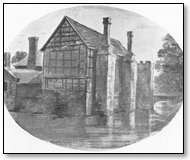
SCOTTISH CASTLES
Whether the mystery of the famous secret room at Glamis Castle, Forfarshire, has ever been solved or satisfactorily explained beyond the many legends and stories told in connection with it, we have not been able to determine. The walls in this remarkable old mansion are in parts over twelve feet thick, and in them are several curious recesses, notably near the windows of the "stone hall." The secret chamber, or "Fyvie-room," as it is sometimes called, is said to have a window, which nevertheless has not led to the identification of its situation. Sir Walter Scott once slept a night at Glamis, and has described the "wild and straggling arrangement of the accommodation within doors." "I was conducted," he says, "to my apartment in a distant corner of the building. I must own, as I heard door after door shut after my conductor had retired, I began to consider myself too far from the living and somewhat too near the dead—in a word, I experienced sensations which, though not remarkable either for timidity or superstition, did not fail to affect me to the point of being disagreeable." We have the great novelist's authority for saying that the entrance of the secret chamber (in his time, at any rate), by the law or custom of the family, could only be known to three persons at once—viz. the Earl of Strathmore, his heir-apparent, and any third person whom they might take into their confidence.
The great mystery of the secret chamber was imparted to the heir of Glamis, or the heir-presumptive, as the case might be, upon the eve of his arriving at his majority, and thus it passed into modern times from the dim and distant feudal days. That the secret should be thus handed down through centuries without being divulged is indeed remarkable, yet so is the story; and many a time a future lord of Glamis has boasted that he would reveal everything when he should come of age. Still, however, when that time did arrive, in every case the recipient of the deadly secret has solemnly refused point blank to speak a word upon the subject.
There is a secret chamber at the old Cumberland seat of the ancient family of Senhouse. To this day its position is known only by the heir-at-law and the family solicitor. This room at Nether Hall is said to have no window, and has hitherto baffled every attempt of those not in the secret to discover its whereabouts.
.Remarkable as this may seem in these prosaic days, it has been confirmed by the present representative of the family, who, in a communication to us upon the subject, writes as follows: "It may be romantic, but still it is true that the secret has survived frequent searches of visitors. There is no one alive who has been in it, that I am aware, except myself." Brandeston Hall, Suffolk, is also said to have a hiding place known only to two or three persons.

